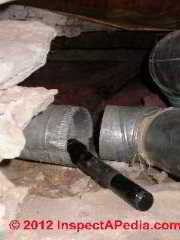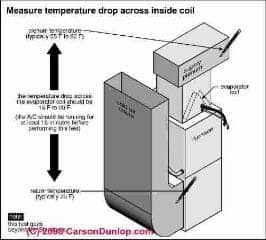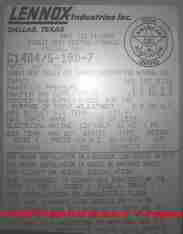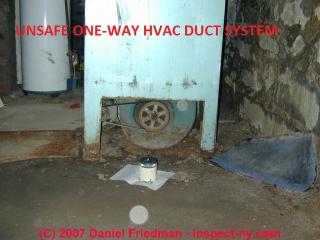 Warm Air Heat Temperatures & Supply Air Temperature Improvement
Warm Air Heat Temperatures & Supply Air Temperature Improvement
Correct weak or cool air from heating registers
- POST a QUESTION or COMMENT about repairing warm air heating systems that blow too-cool
Heating furnace supply air temperatures, flows, & improvements.
This article gives typical heating furnace air temperatures measured at different locations.
This article also describes steps to take in finding and fixing the causes of too-cool air coming from warm air furnace heating supply registers.
Warming up the air supply coming from your heating system may be as simple as re-connecting a loose or disconnected return air duct that is drawing too much cool air from the wrong place in your building.
InspectAPedia tolerates no conflicts of interest. We have no relationship with advertisers, products, or services discussed at this website.
Warm Air Supply Temperature Numbers, Measurements, Improvements
 Question: what is the usual supply air temperature in forced air heating systems?
Question: what is the usual supply air temperature in forced air heating systems?
2018/01/27 Rick said:
What should the temp be at the vent in the room with the stat be at the end of the run, just before the fan shuts off.
This question and reply were posted originally at FURNACE OPERATION DETAILS
Reply: typical supply air temperature for forced air heating: Furnace Temperature Rise or TR
Rick
Here we give basic furnace supply air temperatures but keep in mind that there is not a single "right" or "exact" number for the situation you describe, since the length of vents, insulation, leaks and many other factors will affect supply air temperature and velocity at various supply registers.
Bottom line: the supply air temperature at a room supply register is typically 100°F-110°F.
Measured at the furnace the supply air temperature typically ranges 40-70 °F above the return air temperature.
A furnace data tag will usually give a maximum outlet air temperture (typically around 170°F) as well as a temperature rise (typically 40-70°F).
Watch out: if the supply air temperature at your furnace exceeds the upper limit of temperature rise given on the heater's data tag, inspection and repair are needed since a too-hot furnace heat exchanger can be damaged, might crack, and could leak dangerous combustion gases or carbon monoxide into the building's supply air. Such a system would be unsafe.
Where & How is Heating Furnace Air Temperature Rise or Rise Range Documented & Measured?
 Shown: a Lennox furnace data tag giving maxium air temperature and temperature rise. [Click to enlarge any image]
Shown: a Lennox furnace data tag giving maxium air temperature and temperature rise. [Click to enlarge any image]
Typically a service tech looks at the temperature rise between the temperature of the return air and the supply air measured AT THE FURNACE at installation.
The rated furnace output air temperature is expressed as rise above the return air temperature and is given as a range, usually 30°F between a high and low temperature. This data is found on your heater's data tag. There you will find a statement such as
Supply air temperature rise 30-60 °F or 40-70 °F. On a residential heating furnace you will probably never find a data tag giving a temperature rise of more than 45-75 °F .
Keep in mind this is the temperature degree rise measured by comparing incoming return air temperature to outgoing supply air temperature at the furnace air handler - well actually about 2 meters downstream from the actual heat exchanger.
We don't measure right at the heat exchanger because heat radiated off of the metal surfaces of the heat exchanger itself would give a falsely high "air temperature" reading.
This temperature is measured after the furnace has reached its normal operating temperature.
Fan speed and of course blockages in air-flow (such as a dirty air filter) will affect the actual temperature rise you find.
Typical Furnace Fan Limit Switch Control Temperatures
Building temperatures, that is to say the return air temperature at the furnace, will of course affect the actual temperature you will measure coming out of the air handler or at a warm air supply register in heated space.
FAN LIMIT CONTROL SETTINGS gives is the basic operating temperatures measured at the air handler / furnace heat exchanger.
Factory settings at the fan limit switch typically will be as follows
1. FAN ON: not let the fan turn on until temperature reaches 20°F above the FAN OFF - that's typically around 130°F
2. FAN OFF: the low off number is typically 90°F
3. FAN LIMIT OFF: the high limit is typically factory set at 200°F - a safety level to avoid overheating
Air Temperatures Measured at Supply Registers
Measured downstream from the air handler, in the ductwork or at an individual room air supply register, the temperature will thus always be lower than right at the heat exchanger / supply plenum.
A typical supply air temperature measured at a supply register of a forced air heating system is around 110 degF.
Heating Furnace Runs but Delivers Air that is Cool or Not Warm Enough
8 Feb 2015 brianbe said:
I have a Rheem/Rudd model UGDG05EAUER up flow LP gas fired warm air furnace rated at 50,000 BTU's and 80% efficient. I am not an HVAC guy, but I have always felt that the output temperature of the furnace was too low. I started pouring over the manual and did some research on the internet.
[Click to enlarge any image]
Sketch at left illustrating where to measure temperature drop across a cooling or heating coil was provided courtesy of Carson Dunlop Associates, a Toronto home inspection, education & report writing tool company [ carsondunlop.com ].
I started with checking the heat rise. The furnace is rated for a 20 - 55 degree F rise. I initially measured a supply temperature of ~99 degrees F and a return temperature of ~57 degrees F.
I used a CFM calculation I found on line. I used 1.08 x the 41 degree F rise measured and divided the output BTU's of 42,000 by the previous result of 41 arriving at a CFM rating of ~948.
According to the data charts for this furnace, a speed setting of medium high would give me a CFM of ~900.
I changed the taps and checked the rise again. There was no appreciable difference. I then dropped the heating speed to low and measured again.
Now, the supply temp was ~110 degrees F and the return remained at 57. The furnace is rated for a rise of 25 - 55 degrees F.
With the heat rise now at 52 I was still in the rated heat rise for this furnace. I have read that the typical supply temperature of this type of furnace is `110 - 135 degrees F.
The maximum supply temperature rating for this furnace is 155 degrees F. How can I increase the supply temperature of the furnace while staying within the rated temperature rise of 25 - 55 degrees F?
I was going to check the gas supply pressure before and after the furnace regulator next. The furnace is in an enclosed crawl space that is at ~45 degrees F. The ducts are not insulated. Your help would greatly be appreciated.
I am measuring temperatures in the ducts as the air leaves (supply) and as the air returns (return) to the furnace. I know that I need to insulate the ducts.
Reply: things to check when air temperatures are too low at or leaving the warm air furnace supply plenum
Regarding "How can I increase the supply temperature of the furnace while staying within the rated temperature rise of 25 - 55 degrees F?"
I am guessing you mean the supply air at the registers in the occupied space is too cool. It would make sense to insulate your heating ducts.
Thanks for the clarification.
If air leaving the supply plenum is too cold then I would look for:
- A dirty and partially blocked heat exchanger in the furnace - air is not being adequately warmed as it passes through the heat exchanger.
- Wrong fan speed (too high): air flow rate exceeds the CFM design rate for the furnace in heating mode.
- Improper burner adjustment or flame too small (rare but possible; before measuring or messing with pressure - which is dangerous - just look at the flame to see if it looks normal or weak).
Obviously if there were *no* flame at the gas burner then we'd look for an out-of-fuel problem, power off, thermostat not calling for heat, a bad thermocouple, or a bad flame igniter (on some models this is referred to as a "hot surface igniter).
See NO HEAT - FURNACE - Excessive introduction of outdoor or make-up air

- Improper return air ducting, not recirculating building air but rather always taking "new" supply air from a space that is not receiving heated air (illustrated by my ugly old furnace photo at above left and by the open un insulated crawlspace ducts in my photo at left).
Return duct leak openings where return ducts run from the occupied space through unoccupied space such as a cold attic or crawl space can give the same effect.
See RETURN AIR REGISTERS & DUCTS
and see RETURN DUCT AIR LEAKS
For example I've seen horrible furnace installations that were basically "one-way" heating systems: cold air from a crawl space was the only supply air for the building;
Cold crawl space air was sent through the furnace to be heated and then blown (along with dust and mold) into the occupied space. There were no return ducts from the heated space back to the furnace.
See DUCT SYSTEM DESIGN SIZE & DEFECTS - Check for warm air stratification near the ceiling - details are
at WARM AIR STRATIFICATION INDOORS
Reader Comments, Questions & Answers About The Article Above
Below you will find questions and answers previously posted on this page at its page bottom reader comment box.
Reader Q&A - also see RECOMMENDED ARTICLES & FAQs
On 2019-10-05 by Joe
Can I use a indoor thermometer to check heat temp. at register
On 2018-12-09 by Anonymous
here's two photos
IMAGE LOST by older version of Clark Van Oyen’s useful Comments code - now fixed. Please re-post the image if you can. Sorry. Mod.
IMAGE LOST by older version of Clark Van Oyen’s useful Comments code - now fixed. Please re-post the image if you can. Sorry. Mod.
our upflow gas furnace has a metal plate that slides in and between where the furnace and ductwork meet. Above it somebody wrote "dampner install for spring." my question is, does that mean we remove the metal sheet during winter for use.
On 2017-09-26 by Anonymous
@Josh Mabrey,
It's probably just a duct that is closer to the evap coil
On 2016-11-19 by (mod) -
Josh,
While I agree that a smaller duct diameter will perhaps cause some backpressure and slow down the delivery of warm air at that duct end, I don't think the change in duct diameter would be the full explanation for cooler output from one HVAC heating supply register. I'd be looking for duct leaks or a longer duct run or missing duct insulation.
On 2016-11-19 by Josh Mabrey
Hello we have one floor register that blows quite a bit cooler than the others. The only difference is that at the end the duct switches from 8" down to 6". At that size it turns into the floor register. Could that reduction or the elbow turn or a smaller floor register size be the cause of the heat loss? Thank you
...
Continue reading at AIR FLOW IMPROVEMENT, HVAC or select a topic from the closely-related articles below, or see the complete ARTICLE INDEX.
Or see these
Recommended Articles
Suggested citation for this web page
WARM AIR SUPPLY TEMPERATURE & IMPROVEMENT at InspectApedia.com - online encyclopedia of building & environmental inspection, testing, diagnosis, repair, & problem prevention advice.
Or see this
INDEX to RELATED ARTICLES: ARTICLE INDEX to HVAC DUCT SYSTEMS
Or use the SEARCH BOX found below to Ask a Question or Search InspectApedia
Ask a Question or Search InspectApedia
Try the search box just below, or if you prefer, post a question or comment in the Comments box below and we will respond promptly.
Search the InspectApedia website
Note: appearance of your Comment below may be delayed: if your comment contains an image, photograph, web link, or text that looks to the software as if it might be a web link, your posting will appear after it has been approved by a moderator. Apologies for the delay.
Only one image can be added per comment but you can post as many comments, and therefore images, as you like.
You will not receive a notification when a response to your question has been posted.
Please bookmark this page to make it easy for you to check back for our response.
Our Comment Box is provided by Countable Web Productions countable.ca
Citations & References
In addition to any citations in the article above, a full list is available on request.
- In addition to citations & references found in this article, see the research citations given at the end of the related articles found at our suggested
CONTINUE READING or RECOMMENDED ARTICLES.
- Carson, Dunlop & Associates Ltd., 120 Carlton Street Suite 407, Toronto ON M5A 4K2. Tel: (416) 964-9415 1-800-268-7070 Email: info@carsondunlop.com. Alan Carson is a past president of ASHI, the American Society of Home Inspectors.
Thanks to Alan Carson and Bob Dunlop, for permission for InspectAPedia to use text excerpts from The HOME REFERENCE BOOK - the Encyclopedia of Homes and to use illustrations from The ILLUSTRATED HOME .
Carson Dunlop Associates provides extensive home inspection education and report writing material. In gratitude we provide links to tsome Carson Dunlop Associates products and services.


